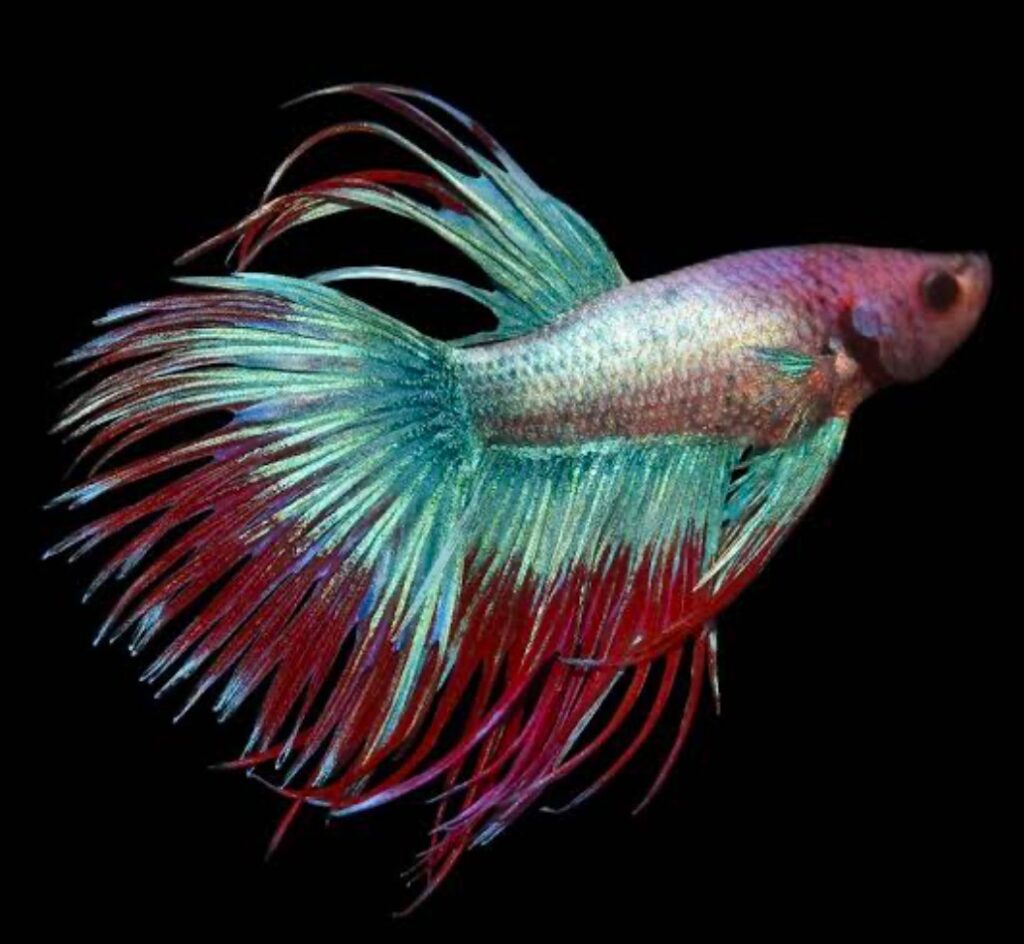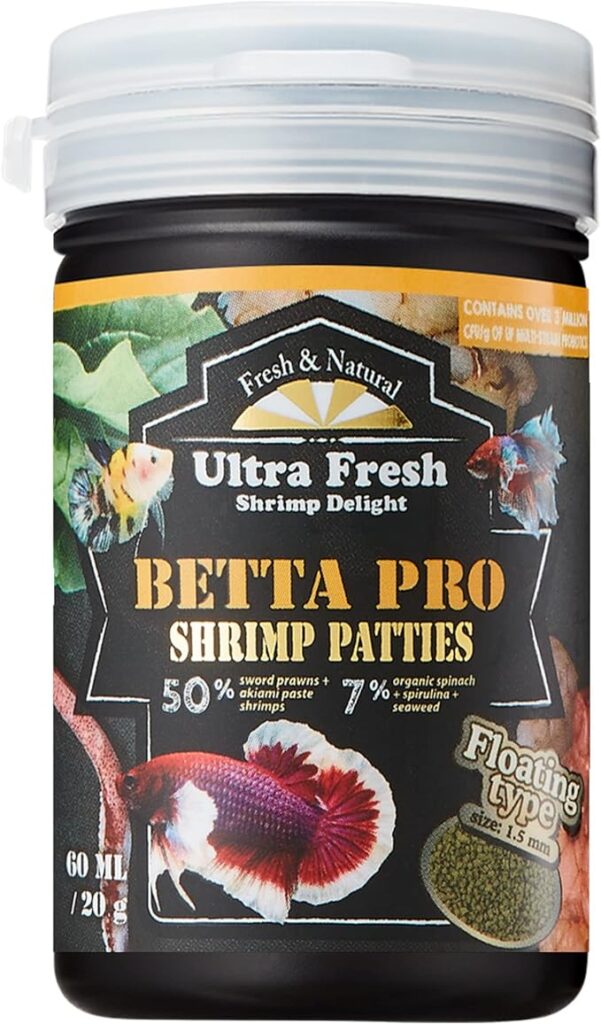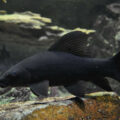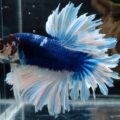In this guide we share how to distinguish between the Crowntail Betta species and other variants to ensure you provide the best possible care, tank setup, feeding, and much more for this species!

Crowntail Betta Fish: A Dramatic Flair of Spiky Elegance
The Siamese fighting fish, commonly known as the betta, is a freshwater fish native to Southeast Asia, namely Cambodia, Laos, Myanmar, Malaysia, Indonesia, Thailand, and Vietnam. In the world of ornamental species, the unique fin structure of the Betta stands out as there are so many subvariants to choose from as a centerpiece in your visually appealing aquarium!
This guide’s focus is on a selective breed of Betta splendens, famous for its unique features, the Crowntail Betta. The Crowntail Betta’s appearance is as colorful as other Splendens species, yet it has a distinctive spiked ray fin.
If you want to keep this crown-finned aquarium fish in your aquarium, this post has the essential info to help you achieve success.
Author’s Note: Check out our post on the The Top 10 Most Popular Betta Fish for even more beautiful Betta varieties!
Size and Swimming Dynamics

Before owning a Crowntail Betta fish, you must understand the average Betta body proportions and swimming pattern to ensure you build a suitable habitat.
Body Proportions
Although the Crowntail Betta dimensions are similar to those of other Betta splendens, there are slight differences. An average Crowntail Betta’s size 2.5 – 3 inches, just like other Bettas, while the giant Crowntail variants grow up to 5 inches long.
Unlike other Bettas, the Crowntail species has less webbing on their fins, which causes spiked rays like a crown’s peak.
Swimming Patterns
This crown-finned fish’s swimming behavior is active and curious. You’d think their spiked fins limit their movement, but it’s the opposite. They appear to glide gracefully as they display their colorful bodies.
Crowntail Bettas investigate their environment and interact with their owners. So, don’t be surprised when they jump in excitement upon recognizing you or seeing food at the surface.
Ideal Habitat Setup for Crowntail Beauty

Consider your species’ size and swimming behavior when designing a Betta tank for long-finned types. There should be ample swimming space with interesting but gentle decor to spike their curiosity and encourage interactions without harming them.
Here are some recommendations for an ideal Crowntail aquarium setup:
Author’s Note: Check out our post on Innovative Betta Fish Tank Designs to inspire your next aquarium setup!
Tank Size and Layout
Get a long tank with a minimum of five gallons of water per Crowntail Betta fish, and ensure there’s a wide swimming area, no matter the interior decor and tank essentials. No, Betta fish can not thrive in tiny cups of water, contrary to popular myths.
Decor
Because your Crowntail Betta is a curious species that’ll interact with its surroundings, it’s best to use gentle and fish-safe decor for fin-sensitive fish.
Plant soft-leaf live vegetation or silk artificial flowers and decorations to prevent tearing of delicate rays.
Filtration and Aquarium Essentials
Keep the tank clean with a gentle filter and set the water flow to a low or moderate pressure to prevent stressing your Crowntail Betta.
Set the following parameters:
- Temperature: 75 – 82
- pH Level: 6.0 – 7.5
- Hardness: 3 – 8dGH
Be sure to use a Master Test Kit to routinely test your tank’s water quality then make adjustments as needed. Maintaining consist water parameters without dramatic or frequent shifts is key to keeping your Betta happy and healthy.
Next up, how to feed your pet Crowntail Betta Fish!
Diet Support for Color and Fin Growth

Found On Amazon
Preparing food for ornamental fish requires special nutrients that support their unique physical appearance and health.
So, for this species, you must incorporate a Betta diet for fin growth with one for color vibrancy and strengthened immunity.
Here’s a recommended Crowntail Betta feeding routine following the golden rules:
| Food for Vibrancy | Treats that are rich in Carotenoids |
| Food for Fin Strength | High-protein diet made of Pellets, Frozen bloodworms |
| Food for Immunity | Protein-rich diet, Vitamins and Magnesium |
Author’s Note: For more on feeding your aquatic pets check out The Ultimate Guide to Fish Food: Pros and Cons & Best Choices!
Choose floating pellets to encourage your Crowntail Bettas to swim to the surface.
Behavior and Display Temperament

Let’s look closer at the Crowntail Betta personality and now it behaves in aquariums. Like other Bettas, the Crowntail species flare their gills and fins to appear larger and intimidate other species and fish.
If you’ve never noticed the flaring Betta behavior or have zero experience with it, it’s best to avoid the Crowntail Betta. That’s because, despite being curious pets, they have a semi-aggressive temperament, which makes them better for solitary tanks.
You can still enjoy their interactive fish traits when they stay alone, as they love to show off near mirrors or tank dividers and get excited during feeding time.
Breeding the Crowned Fin Style
You must follow a careful, selective breeding process to preserve the unique Betta fin genetics.
Follow these Crowntail Betta breeding tips to avoid making common mistakes and ensure you raise the healthiest species.
- Select a spiky fin male and female to retain their unique crown tail genetics
- Maintain pristine water conditions
- Set appropriate parameters as recommended above
- Feed the breeders accurately
The male Crowntail Betta will create a bubble nest, encouraging the female to come and mate. If she agrees, she’ll lay her eggs within the bubble while the male stands guard.
The males take on the responsibility of raising Betta fry, but you can support them by providing a conducive environment for healthy growth and development.
Feed the baby Betta fish crushed food until they’re grown enough to eat normal-sized pieces. Once they mature, you can move the Crowntail Betta to an adult aquarium.
Tank Mates to Avoid and Consider
Typically, Crowntail Bettas are solitary pets, but with careful tank mate selection, you can build a harmonious community.
Add only peaceful and Betta-friendly companions like Kuhli loaches, Harlequin Rasboras, Mystery snails or shrimp while avoiding fin nippers like barbs or guppies with flashy tails that’ll stress or harm your pet.
Author’s Note: For more on Betta tankmates checkout The 13 Popular Betta Tankmates for a 5 Gallon Aquarium!
Fin Maintenance and Common Issues
Because of their elaborate spiked tails, maintaining Betta fins is a major part of the Crowntail species’ healthcare.
Some common issues with fancy Bettas include fin rot, tearing, and fungal infections, which are all effects of poor water quality and untreated fin injuries.
When you follow the rules in this Crowntail Betta care guide, from the tank maintenance to the dietary needs, you’d reduce the risk of disease.
In case of illness, follow these steps:
- Quarantine the affected fish
- Change the water
- Ensure proper water quality
- Apply anti fungal or anti bacterial cream on the affected area
Once your fish recovers you can return it to the general tank.
Conclusion: A Crown-Worthy Choice for Betta Lovers
It’s time to close the curtain on this ornamental Betta spotlight but before that, let’s recap on the things you’ve learned about Crowntail Betta care.
What makes this species special and a centerpiece fish for tanks?
- It has a unique tail fin shape
- It comes in different colors
- It fits in medium-sized tanks
- It’s easy to maintain
Don’t make your Crowntail Betta decision lightly. Take your time to review its care needs and your capacity to ensure you can dedicate time to it. If the answer is yes, you can add this dramatic beauty to your tank!
Author’s Note: As a bonus for making it to the end of this post, we recommend checking out the 9 Extremely Rare Types of Betta Fish for even more beautiful and unique Betta varieties!
Please share your experiences and pictures of your Betta Fish in the comment box below.










